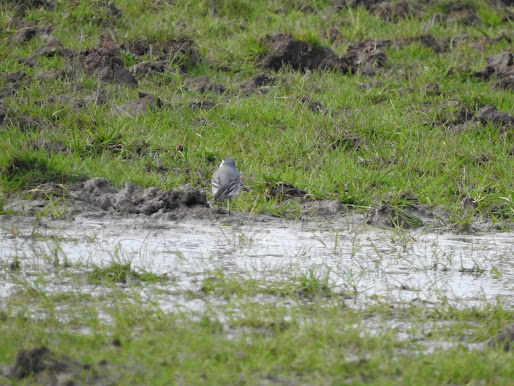Since the weekend the doorway to spring has been slammed shut. Cold northerly winds have set in and it seems likely that there will be fewer new migrants getting through until warm winds return.
Today I decided to pay another visit to Rough Hill Wood in the hope of finding some interesting woodland species. The result was just a few Chiffchaffs, Blackcaps, and Willow Warblers. But arguably the highlight was a Marsh Tit which was, just about, photographable.
 |
| Marsh Tit |
Distinguishing between silent Marsh Tits and Willow Tits has always been difficult. This one was calling (and obviously Willow Tits appear to be locally extinct), but one "feature" which is said to be pretty reliable is the presence or absence of a white mark on the upper mandible. I've never really looked for it on a fast moving live bird, but a camera helps to freeze time. I believe that this photo does show that feature, further confirming that it is indeed a Marsh Tit.
Upon leaving the wood I drove up the road to Mappleborough Green to see if there was anything there. This proved to be a good move. The Cattle Egret was absent, the only Egret being a single Little Egret, but I was really hoping for waders, and there was indeed something new on the main flash. Ok, it was just a Common Sandpiper, but it was still a sign that birds are moving despite the weather.
 |
| Common Sandpiper |
Also present was a Green Sandpiper and three Little Ringed Plovers. These were mainly on the overflow flash, where I also noticed a Pipit. I'd left my scope at home so it took me longer than it should have to establish that the only Pipits present were Meadow Pipits (four of them).
However, whilst I was creeping about, an interesting Alba Wagtail appeared. I immediately suspected it was a different sub-species from the several Pied Wagtails which were also present. It was indeed a White Wagtail.
 |
| White Wagtail |
Female Pied Wagtails can look pale mantled, and indeed there was a pale mantled female Pied with the black-backed males, but it didn't look quite as pale as this bird.
For the removal of all doubt it is desirable to see how far down the rump the pale grey extends. For a White Wagtail it needs to go almost down as far as the tail. This bird passed the test.
 |
| Lots of pale grey on the rump, though the bird's a bit distant |
 |
| That'll do |
It appears to be still in winter plumage, and maybe it's a female because of the extent of grey leaching onto the crown.
This bird is probably en route to Iceland, which shares the nominate race with the rest of western Europe. Our Pied Wagtails are almost restricted to the British Isles.
White Wagtails are fairly frequently encountered in mid April, but I rarely see more than one or two a year around here.
No comments:
Post a Comment